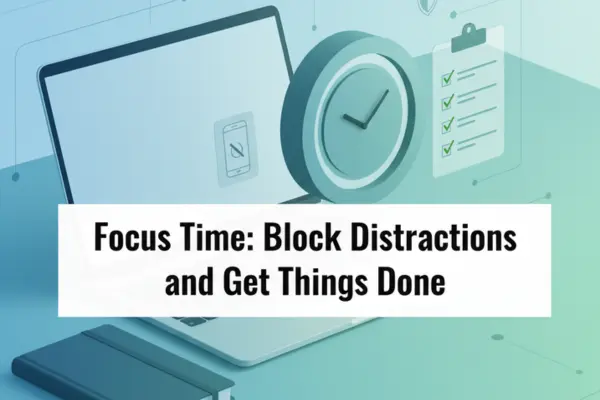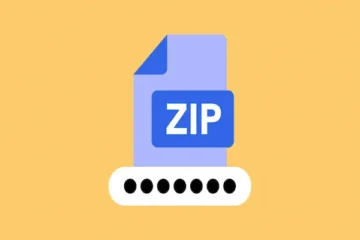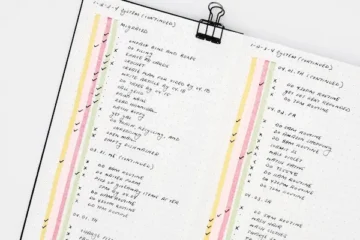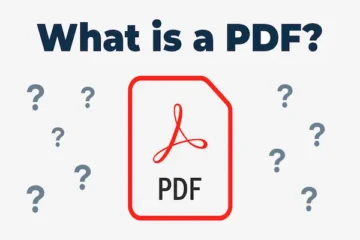Focus Time: Block Distractions and Get Things Done
Learn how to set focus time to block distractions, stay productive, and get things done with simple, practical strategies for everyday life.
It’s hard to stay focused in the middle of so many notifications, noises, and last-minute tasks.
You check your phone for a quick message, and suddenly 20 minutes are gone scrolling through social media.
Or you start an important task, only for someone to interrupt with a “quick question” that turns into half an hour wasted.
If this sounds familiar, know that it’s not about lack of discipline.
The problem is that the modern world is designed to steal your attention.
The good news is that there’s a practical way to regain control: learning how to set focus time to block distractions and make sure things actually get done.
In this article, you’ll discover how to schedule deep concentration periods, which techniques work best, common mistakes to avoid, and tools that can transform your productivity.

Understanding how to set focus time
Before applying any technique, it’s important to expand on what focus time really means.
It goes far beyond simply “trying harder to concentrate.”
Instead, focus time is about intentionally creating an environment and a mindset where your brain can dedicate its energy to a single activity without unnecessary interruptions.
When you practice how to set focus time, you begin to see that concentration is not about forcing willpower.
It’s about designing the right conditions, choosing the right moments, and building habits that support your productivity.
- Focus is energy directed toward a single task – when you spread your attention across multiple activities, none of them get your full potential.
- The brain performs best in concentrated blocks of time – studies show that deep focus sessions are far more effective than multitasking.
- Distractions break reasoning and extend execution time – every time you stop to check your phone or reply to a message, your brain takes several minutes to fully return to the task.
- The key is protecting focus time as if it were a non-negotiable appointment – schedule it in your calendar, respect it, and treat it with the same importance as a meeting with your boss or a doctor’s visit.
- Environment plays a critical role – quiet surroundings, a tidy workspace, and limited digital distractions create the perfect setting for concentration.
- Preparation reduces resistance – having all the materials you need ready before you start keeps you from losing momentum.
By understanding these principles, you stop seeing focus as a matter of luck or personality and start treating it as a skill that can be built, protected, and strengthened with the right strategies.
Benefits of how to set focus time
Dedicating blocks of deep focus gives you an advantage that goes far beyond simply finishing tasks.
It reshapes the way you work, how you feel during the process, and even how you evaluate your progress at the end of the day.
When you truly learn how to set focus time, you stop relying on scattered attention and start experiencing balance, clarity, and greater efficiency.
Here are the expanded benefits explained in detail:
- Real productivity – Focus sessions allow you to dedicate your full energy to one activity, which means you get more done in less time. Tasks that normally drag on for hours can be completed in a fraction of that when distractions are removed.
- Less stress – Without constant interruptions, your brain enters a natural flow state. This reduces the frustration of switching between activities and gives you a calmer work rhythm.
- Higher quality – Concentration lets you notice details you’d normally miss. The result is cleaner writing, more precise analysis, or more thoughtful problem-solving.
- Mental clarity – Structured focus blocks give your mind order and direction. Instead of juggling multiple unfinished tasks, you know exactly what deserves your attention at each moment.
- Extra motivation – Every time you complete a focus session, you feel a sense of accomplishment. That feeling builds momentum, making it easier to keep the habit going.
- Better time management – Dividing your day into intentional focus periods helps you use your time wisely. You stop wasting energy on distractions and start moving steadily toward your goals.
- Increased confidence – As you consistently finish important work, you begin to trust yourself more. Each completed task becomes proof that you’re capable of staying disciplined and productive.
In short, focus time is more than a technique — it’s a lifestyle change.
It allows you to protect your attention, increase efficiency, and enjoy the peace of mind that comes from knowing you are in control of your time and results.
Common mistakes in how to set focus time
Trying to build focus time into your day is a powerful habit, but many people give up early because they fall into common traps.
These mistakes make the process harder than it needs to be, turning a simple strategy into a source of frustration.
When you understand what to avoid, learning how to set focus time becomes much easier and more sustainable.
Here are the most frequent errors explained in more depth:
- Keeping your phone nearby – Even on silent mode, just seeing your phone within reach tempts you to check it. Each “quick glance” breaks your concentration and costs several minutes to regain full focus. The solution is simple: put your phone in another room or use an app that locks distracting apps during your session.
- Trying sessions that are too long at first – Starting with 2-hour focus blocks usually leads to fatigue and discouragement. It’s best to begin with manageable periods of 25–40 minutes and gradually increase as your concentration muscle strengthens.
- Not informing others – If coworkers, friends, or family don’t know you’re in focus mode, they’ll naturally interrupt. A simple signal — like closing your office door, wearing headphones, or telling them in advance — creates the boundaries you need.
- Choosing the wrong times – Everyone has different energy peaks. Some concentrate better in the morning, others in the afternoon or evening. Scheduling focus time at your lowest energy point sets you up for failure. Instead, align your blocks with your natural rhythm.
- Not reviewing results – Setting focus blocks is only half the process. You need to regularly review whether you used the time well, what distracted you, and how you can improve next time. Without reflection, the habit loses power and stops evolving.
- Being too rigid – Some people give up because they expect perfection. Missing a session or adjusting your block doesn’t mean you failed. Flexibility is what makes focus time a sustainable habit.
By recognizing and avoiding these mistakes, you create a smoother path to consistency.
The more you adapt focus time to your reality, the greater the chances of making it a lasting part of your routine — one that actually helps you finish what matters most.
How to set focus time step by step
Here’s a practical guide to building focus sessions.
Choose your priority
Define the task that deserves your attention and why.
Prepare your environment
Keep everything you need close by and eliminate possible distractions.
Define your time block
Start with 30 minutes and increase gradually as your discipline grows.
Use support techniques
Methods like Pomodoro help you maintain rhythm.
Notify those around you
Explain that you can’t be interrupted during this period.
Review and adjust
At the end, evaluate what worked and what can be improved.
Tools for how to set focus time
There are several tools that can help you maintain discipline during focus time.
| Tool | Main function | Best for |
|---|---|---|
| Forest | Blocks apps + gamified focus | People motivated by gamification |
| Focus To-Do | Pomodoro technique + tasks | People who like visual structure |
| Freedom | Blocks websites and apps | People who need strict discipline |
| Google Calendar | Schedules with reminders | People who want simplicity |
| Paper planner | Manual control | People who prefer pen and paper |
How to set focus time at work
In the workplace, focus time is crucial for handling strategic tasks.
- Block time in your calendar as real appointments.
- Let your team know not to interrupt you.
- Dedicate focus blocks to the highest-impact tasks.
- Keep meetings short and protect the rest of your time.
How to set focus time in personal life
Focus isn’t just useful at work.
At home, dedicating blocks of concentration can help with studying, personal projects, and even quality leisure.
- Set fixed times for reading or online courses.
- Use focus sessions for home organization or cleaning.
- Practice hobbies without splitting attention between TV or phone.
How to set focus time with flexibility
Some people think focus requires rigid rules.
But in reality, flexibility is what makes the practice sustainable.
- If you can’t do an hour, do 20 solid minutes.
- Adjust block lengths to match your energy levels.
- Allow strategic breaks to avoid burnout.
How to set focus time and stay motivated
Motivation sustains the focus habit.
That’s why you should celebrate each completed block as a small victory.
- Check off each finished session in a planner.
- Reward yourself with enjoyable breaks.
- Notice the positive impact on your results to reinforce the habit.
Best practices for how to set focus time
To make this habit stick long-term, follow these best practices:
- Start with short blocks and increase gradually.
- Eliminate distractions before you begin.
- Respect your natural energy peaks.
- Stay flexible without losing consistency.
- Review your results weekly.
Compliance and transparency
This article is educational and aims to teach how to set focus time in a practical and accessible way.
We have no partnership, affiliation, or control over any apps, brands, or platforms mentioned.
The information provided is general and should be adapted to your own reality.
Our goal is to provide safe, reliable content aligned with Google’s compliance and best practice guidelines.




